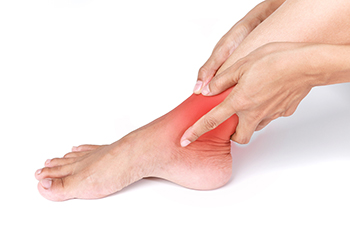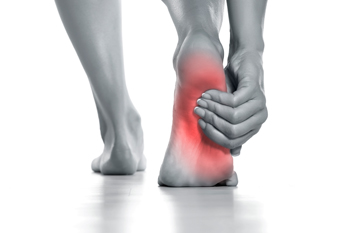Connect With Us
Blog
Causes and Symptoms of Chronic Ankle Pain

Chronic ankle pain refers to persistent discomfort in the joint that lasts for an extended period and may interfere with daily activities. Symptoms include ongoing pain, difficulty walking, foot swelling, and visible bruising. Many individuals also experience a limited range of motion, making it hard to move the ankle freely or bear weight comfortably. Several conditions can contribute to chronic ankle pain, such as tendonitis, where the tendons become inflamed due to overuse or injury. Arthritis is another common cause, leading to joint stiffness and swelling over time. Additionally, ankle instability, often the result of repeated sprains or weakened ligaments, may cause the joint to feel wobbly or prone to giving way. Chronic ankle pain often causes difficulty in completing daily activities. If you have any of the above symptoms, it is strongly suggested that you are under the care of a podiatrist who can start you on a comprehensive treatment plan.
Ankle pain can be caused by a number of problems and may be potentially serious. If you have ankle pain, consult with one of our podiatrists from Foot & Ankle Associates of Maine. Our doctors will assess your condition and provide you with quality foot and ankle treatment.
Ankle pain is any condition that causes pain in the ankle. Due to the fact that the ankle consists of tendons, muscles, bones, and ligaments, ankle pain can come from a number of different conditions.
Causes
The most common causes of ankle pain include:
- Types of arthritis (rheumatoid, osteoarthritis, and gout)
- Ankle sprains
- Broken ankles
- Achilles tendonitis
- Achilles tendon rupture
- Stress fractures
- Bursitis
- Tarsal tunnel syndrome
- Plantar fasciitis
Symptoms
Symptoms of ankle injury vary based upon the condition. Pain may include general pain and discomfort, swelling, aching, redness, bruising, burning or stabbing sensations, and/or loss of sensation.
Diagnosis
Due to the wide variety of potential causes of ankle pain, podiatrists will utilize a number of different methods to properly diagnose ankle pain. This can include asking for personal and family medical histories and of any recent injuries. Further diagnosis may include sensation tests, a physical examination, and potentially x-rays or other imaging tests.
Treatment
Just as the range of causes varies widely, so do treatments. Some more common treatments are rest, ice packs, keeping pressure off the foot, orthotics and braces, medication for inflammation and pain, and surgery.
If you have any questions, please feel free to contact our office located in Brunswick, ME . We offer the newest diagnostic and treatment technologies for all your foot care needs.
How to Manage a High Ankle Sprain

A high ankle sprain happens when the ligaments that hold the two lower leg bones together, just above the ankle, are stretched or torn. This usually occurs when the foot twists outward or is pushed upward with force, as may be common during sports activities. Symptoms of a high ankle sprain include pain while walking, especially when trying to rise onto the toes, but there may not be much swelling at first. Because this type of sprain affects deeper parts with the ankle joint, it can be harder to diagnose without proper testing. A podiatrist can examine the ankle and may order X-rays or more detailed scans to look for signs of torn ligaments or broken bones. If the bones have moved apart, surgery may be needed to hold them in place while the area heals. If the bones are still aligned, a cast or walking boot may be used to keep weight off the ankle while it recovers. If you have sprained an ankle, it is suggested that you schedule an appointment with a podiatrist for an exam, diagnosis, and appropriate treatment.
Ankle sprains are common but need immediate attention. If you need your feet checked, contact one of our podiatrists from Foot & Ankle Associates of Maine. Our doctors can provide the care you need to keep you pain-free and on your feet.
How Does an Ankle Sprain Occur?
Ankle sprains take place when the ligaments in your ankle are torn or stretched beyond their limits. There are multiple ways that the ankle can become injured, including twisting or rolling over onto your ankle, putting undue stress on it, or causing trauma to the ankle itself.
What Are the Symptoms?
- Mild to moderate bruising
- Limited mobility
- Swelling
- Discoloration of the skin (depending on severity)
Preventing a Sprain
- Wearing appropriate shoes for the occasion
- Stretching before exercises and sports
- Knowing your limits
Treatment of a Sprain
Treatment of a sprain depends on the severity. Many times, people are told to rest and remain off their feet completely, while others are given an air cast. If the sprain is very severe, surgery may be required.
If you have suffered an ankle sprain previously, you may want to consider additional support such as a brace and regular exercises to strengthen the ankle.
If you have any questions please feel free to contact our office located in Brunswick, ME . We offer the newest diagnostic and treatment technologies for all your foot and ankle needs.
How Injuries Happen to the Lower Limbs

Young people are more likely to get hurt while being active, whether running, jumping, or engaging in fast-paced activities. Rough sports that involve tackling or aggressive contact, such as rugby and martial arts, increase the chances of harm. Speed-based activities like cycling, skating, and downhill winter sports also pose a danger. The most commonly affected areas are below the knee, where damage to the soft tissues, ligaments, or bones can occur. If harm happens close to a major joint, the area responsible for bone development could be impacted and should be examined by a specialist. As people age, they become more vulnerable to falls and fractures. The loss of muscle and reduced bone density over time make healing harder. Decreased vision and balance problems also raise the likelihood of accidents. Regardless of your age, if you have a foot or ankle injury, it is suggested that you see a podiatrist for a proper diagnosis and appropriate treatment.
Sports related foot and ankle injuries require proper treatment before players can go back to their regular routines. For more information, contact one of our podiatrists of Foot & Ankle Associates of Maine. Our doctors can provide the care you need to keep you pain-free and on your feet.
Sports Related Foot and Ankle Injuries
Foot and ankle injuries are a common occurrence when it comes to athletes of any sport. While many athletes dismiss the initial aches and pains, the truth is that ignoring potential foot and ankle injuries can lead to serious problems. As athletes continue to place pressure and strain the area further, a mild injury can turn into something as serious as a rupture and may lead to a permanent disability. There are many factors that contribute to sports related foot and ankle injuries, which include failure to warm up properly, not providing support or wearing bad footwear. Common injuries and conditions athletes face, including:
- Plantar Fasciitis
- Plantar Fasciosis
- Achilles Tendinitis
- Achilles Tendon Rupture
- Ankle Sprains
Sports related injuries are commonly treated using the RICE method. This includes rest, applying ice to the injured area, compression and elevating the ankle. More serious sprains and injuries may require surgery, which could include arthroscopic and reconstructive surgery. Rehabilitation and therapy may also be required in order to get any recovering athlete to become fully functional again. Any unusual aches and pains an athlete sustains must be evaluated by a licensed, reputable medical professional.
If you have any questions please feel free to contact our office located in Brunswick, ME . We offer the newest diagnostic and treatment technologies for all your foot and ankle needs.
Sources of Foot Pain

Foot pain can stem from plantar fasciitis, tendonitis, bunions, or arthritis. Plantar fasciitis causes sharp pain in the heel, particularly with the first steps in the morning. Tendonitis involves inflammation of the tendons, leading to pain, swelling, and limited movement, often affecting the arch or back of the foot. A bunion is a bony bump at the base of the big toe, making it painful to wear shoes and walk. Arthritis in the foot causes joint pain, stiffness, and swelling, often worsening with activity. The causes of foot pain vary, but common factors include overuse, wearing improper footwear, abnormal foot structure, or aging. Symptoms often include swelling, tenderness, and difficulty moving or bearing weight on the affected foot. A podiatrist can assess your symptoms and provide treatment options, including targeted exercises, custom orthotics, medication, or surgery, if needed. If you have ongoing foot pain, it is suggested that you schedule an appointment with a podiatrist.
Foot Pain
Foot pain can be extremely painful and debilitating. If you have a foot pain, consult with one of our podiatrists from Foot & Ankle Associates of Maine. Our doctors will assess your condition and provide you with quality foot and ankle treatment.
Causes
Foot pain is a very broad condition that could be caused by one or more ailments. The most common include:
- Bunions
- Hammertoes
- Plantar Fasciitis
- Bone Spurs
- Corns
- Tarsal Tunnel Syndrome
- Ingrown Toenails
- Arthritis (such as Gout, Rheumatoid, and Osteoarthritis)
- Flat Feet
- Injury (from stress fractures, broken toe, foot, ankle, Achilles tendon ruptures, and sprains)
- And more
Diagnosis
To figure out the cause of foot pain, podiatrists utilize several different methods. This can range from simple visual inspections and sensation tests to X-rays and MRI scans. Prior medical history, family medical history, and any recent physical traumatic events will all be taken into consideration for a proper diagnosis.
Treatment
Treatment depends upon the cause of the foot pain. Whether it is resting, staying off the foot, or having surgery; podiatrists have a number of treatment options available for foot pain.
If you have any questions, please feel free to contact our office located in Brunswick, ME . We offer the newest diagnostic and treatment technologies for all your foot care needs.
